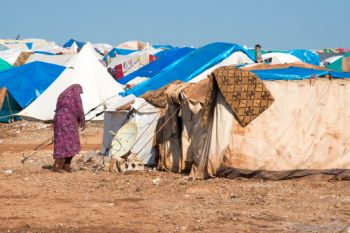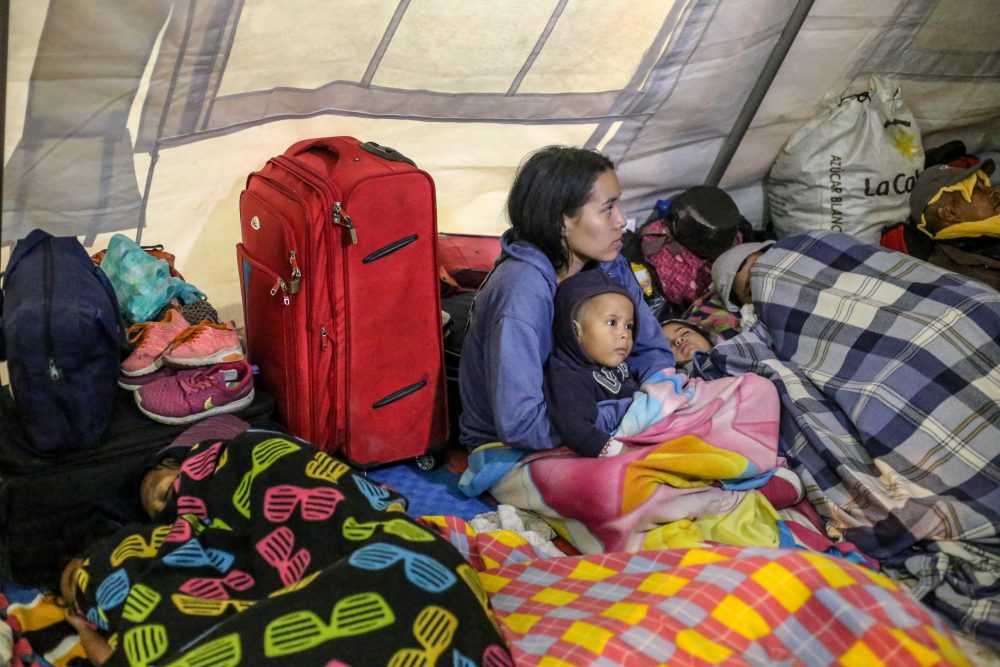
Emergency and Interim Shelter
After a disaster, shelter is more than a place to rest, it is a place of security, access to food, water and medical treatment. A place to start recovering after a disaster.
Overview
“Shelter” conjures up images of safety, security, fortification and a place to call your own. It is more than protection from the environment, it is what grounds people to their family and community. Disasters, both manmade and natural, can strip that connection away and leave people vulnerable to violence, disease, malnutrition and dehydration. It can result in increased vulnerability for already vulnerable populations. After a disaster, shelter is more than a place to rest, it is a place of security, access to food, water and medical treatment. A place to start recovering after a disaster.

Despite ongoing work, and lessons learned from previous disasters, shelter for people affected by disasters remains a challenge. Emergency and interim shelter during and after disasters relies on efficient and effective response plans, logistics and sufficient capacity among responding organizations to maintain the appropriate levels of service. Victims of disasters, refugees fleeing violence and poverty and displaced people who are unable to return home all rely on emergency and interim shelter.
Well-planned and executed shelter facilities can ease the transition from pre-disaster life to post-disaster life for people worldwide. Emergency and interim shelters should be expected during the response phase of a disaster, when outside services and infrastructure may be limited or non-existent. As a result, they require appropriate planning and pre-positioning of necessary supplies in locations that can be easily accessed without outside help. While some may continue to operate into the recovery phase, they are not intended to be a permanent solution to housing needs after a disaster.
In some situations, like the complex humanitarian emergencies in Yemen and Venezuela these shelter facilities become de facto homes and housing, especially for refugees and internally displaced people. When people have fled their homes because of violence, poverty or any other reason, they do not necessarily have time to ensure shelter or housing is available. Many of them will end up in emergency or interim shelters and camps while they await the opportunity to emigrate or return to their homes and rebuild their lives.
The United Nations High Commission for Refugees (UNHCR) said in its report Forced Displacement in 2018 that 13.6 million people were newly displaced that year, both inside their own country and to other countries. In 2018, there were 70.8 million people who were forcibly displaced worldwide. Two-thirds of the displaced people around the world came from just five countries: Syria, Afghanistan, South Sudan, Myanmar and Somalia. Half of those were children, of whom at least 138,600 were considered to be unaccompanied or separated from their families, though the UNHCR believes that to be a “significant understimate.”
Developed nations will have less of a need for emergency and interim shelter, thanks to strong building codes and private insurance. Strong building codes that are regularly enforced mean that buildings are less likely to be damaged when a disaster happens. Private insurance will allow the financial risk to be spread among a large group of people, providing faster reconstruction. People in developed nations are also less likely to become internally displaced or refugees because of strong social supports and government assistance. However, some immediate shelter assistance will be required during an evacuation and the immediate aftermath of a disaster. In the U.S., these are usually run by the American Red Cross (as part of their Congressional Charter), by faith groups or by the local municipality. Post-disaster, the Federal Emergency Management Agency (FEMA) may provide financial assistance for rent or launch a Transitional Sheltering Assistance program whereby FEMA covers the cost of lodging at a hotel or motel for impacted people.
Still-developing nations have seen a major influx of people to large urban areas, which is resulting in buildings that are built quickly, without much oversight to ensure adequate building codes and standards. Rapid population growth, along with poorly constructed buildings, can also lead to overcrowding and its related challenges. Poor sanitation, difficulties in accessing food and clean water, as well as the increased potential for a disaster to cause an overwhelming number of injuries and fatalities are all challenges with rapidly increasing urban populations. It also increases the chance for large numbers of people to need shelter in some of the most heavily affected areas after a disaster.
Key Facts
- The most effective strategies for interim and emergency shelter consider the entire shelter cycle, including the root causes of emergency and interim shelter needs; how people will access shelter; resources and services they will need; and how they will transition into long-term housing. Focusing solely on the provision of shelter can lead to inefficient use of resources and duplication of efforts, especially when the situation leading to the need for shelter could be prevented or mitigated.
- Those most likely to be affected should be involved in shelter plans—preferably long before a disaster occurs. Participation by local leaders, vulnerable populations and communities is essential for any recovery plan to work. Communities recover as communities, not as individuals.
- Plans should be designed to meet the needs of the most vulnerable first. Emergency and interim shelter should be designed to meet the needs of those who need the most support. Older adults, people with disabilities and functional needs and women and girls become much more vulnerable when emergency and interim shelter is required.
- Even in developed nations, private philanthropy plays an essential role in the rebuilding of communities. Government assistance and insurance only go so far in meeting needs, particularly when there have been multiple major disasters, or the affected area is very large.
- Urban areas need special consideration. In the aftermath of a disaster, there may be more rubble from affected buildings, in addition to damage to roads and other infrastructure. Urban areas may also include a higher percentage of vulnerable or resource-poor populations, with less ability to withstand or recover from disaster on their own.
- Improved planning and smarter building can act as mitigation. In Bangladesh, for example, a nation heavily impacted by annual floods, communities have worked with nongovernmental organizations (NGOs) and others to raise houses above flood levels; establish flood shelters that can accommodate up to 300 families each; build raised-tube wells for clean water; improve warning communications; and keep rescue boatsready.
- Much can be learned from past experience, both domestically and internationally. There are many opportunities not only for the study of best practices, but also for working toward implementation of those practices in vulnerable communities worldwide.
- Emergency and interim shelter is one of nine thematic clusters identified by the United Nations for greater coordination in humanitarian crises. UNHCR shares leadership of the United Nations’ emergency shelter cluster with the International Federation of Red Cross and Red Crescent Societies (IFRC).
How to Help
- Do not stop at relief. Support efforts that increase focus on disaster planning in addition to longer-term recovery of communities.
- Remember the needs of vulnerable populations. Tenuous situations prior to a disaster are only exacerbated during and after an event. Ensure that shelter plans, for example, are appropriate for those with disabilities and help fund communication efforts that spread necessary information to those who might not otherwise receive it.
- Build capacity of NGOs with long-standing ties in areas of concern. These agencies are more likely to work with local agents and deliver the most efficient, appropriate services and results.
- Fund collaborative efforts between NGOs, government agencies and the building/engineering communities to develop best practices. The Engineering & Construction Disaster Resource Partnership (DRP), for example, works toward coordinated private sector partnership in response to natural disasters.
- Post-disaster, support programs that help those affected recover. Funding of microloans for rebuilding and livelihood opportunities in the removal of rubble, etc. help restore community pride and purpose.
- Fund assessments of areas vulnerable to natural disasters. Consider NGO and government capacity, in addition to past events.
- Do not forget funding for large-scale debris removal in urban areas. Often overlooked in disaster planning, rubble from damaged infrastructure can stand in the way of efforts to rebuild, unnecessarily extending the need for shelters.
- Consider and support the development/availability of innovative shelter structures. Over the years, numerous designs have offered lower-cost, more efficient and/or more sustainable options.
What Funders Are Doing
- In 2019, the Coca-Cola Foundation donated $400,000 to the Salvation Army to provide immediate emergency food and shelter relief to the islands of Grand Bahama and Abaco after Hurricane Dorian.
- In 2018, the NoVo Foundation donated $500,000 to BRAC USA to provide shelter, along with other necessary supports to Rohingya refugees in Bangladesh with a focus on the needs of adolescent girls.
- In 2018, the Kaiser Permanente Corporate Giving Program committed up to $1 million to multiple organizations to support victims of the Camp Fire while also deploying medical and nursing volunteers to people living in emergency and interim shelters.
- In 2018, the International Community Foundation gave a $5,000 grant to Amigos de los Ninos de Cabo San Lucas (Friends of the Children) to provide emergency shelter and materials to help low income families who lost their houses and all possessions.
- A $2,000 grant from the Foundation for a Healthy St. Petersburg helped the Community Development and Training Center purchase of food and additional supplies for an emergency shelter established in the Childs Park community in response to Hurricane Irma.
Learn More
- FEMA’s Functional Needs Support Services Guidance
- The Americans with Disabilities Act and Emergency Shelters
- Global Shelter Cluster
- Ready.gov: Shelter
- Centers for Disease Control and Prevention: Shelters (Evacuation and Emergency)
- DisasterAssistance.gov: Emergency Shelter
We welcome the republication of our content. Please credit the Center for Disaster Philanthropy.